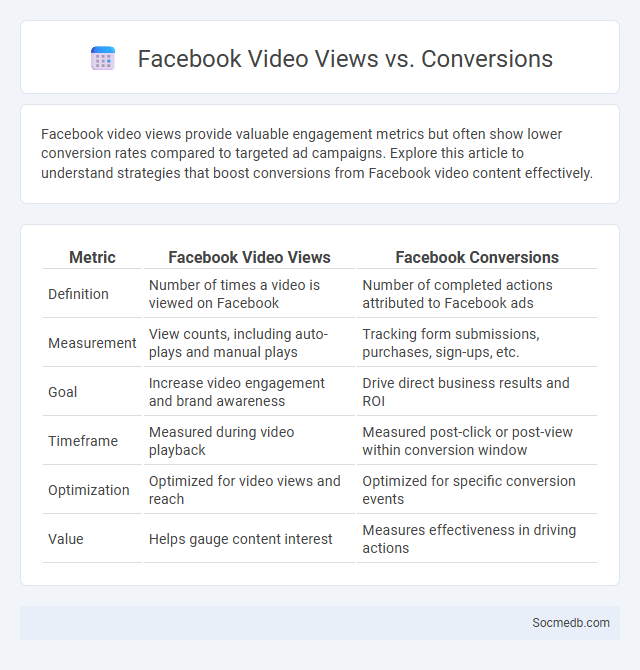
Photo illustration: Facebook Video Views vs Conversions
Facebook video views provide valuable engagement metrics but often show lower conversion rates compared to targeted ad campaigns. Explore this article to understand strategies that boost conversions from Facebook video content effectively.
Table of Comparison
| Metric | Facebook Video Views | Facebook Conversions |
|---|---|---|
| Definition | Number of times a video is viewed on Facebook | Number of completed actions attributed to Facebook ads |
| Measurement | View counts, including auto-plays and manual plays | Tracking form submissions, purchases, sign-ups, etc. |
| Goal | Increase video engagement and brand awareness | Drive direct business results and ROI |
| Timeframe | Measured during video playback | Measured post-click or post-view within conversion window |
| Optimization | Optimized for video views and reach | Optimized for specific conversion events |
| Value | Helps gauge content interest | Measures effectiveness in driving actions |
Understanding Facebook Video Metrics: Views, Conversions, and Video View
Understanding Facebook video metrics like views, conversions, and video view duration is crucial for optimizing your content strategy. Views indicate how many times your video has been watched, while conversions measure the actions taken by viewers after watching, such as clicks or purchases. Monitoring video view duration helps you gauge engagement and identify which parts of your video resonate most with Your audience.
Defining Facebook Video Views: What Counts as a View?
Facebook video views are counted once a user watches the video for at least three seconds, making short, engaged interactions critical to your content's performance. Autoplay videos that sound off still count toward views, but longer watch times contribute to better reach and algorithm favorability. Understanding these metrics helps you optimize your strategy to increase genuine audience engagement and improve visibility on the platform.
What are Facebook Video Conversions?
Facebook Video Conversions refer to the measurable actions taken by users after watching a video ad on Facebook, such as clicking a link, signing up for a newsletter, or making a purchase. These conversions are tracked through Facebook Pixel or SDK, enabling advertisers to analyze the effectiveness of their video campaigns in driving specific user behaviors. Optimizing for video conversions helps increase return on ad spend by targeting audiences likely to engage and complete desired actions.
Video View vs Video Views: Key Semantic Differences
Video View refers to a single instance where a user watches a video, often counted when the viewer reaches a minimum watch duration, while Video Views indicate the total number of times your video has been watched, including multiple views by the same user. Understanding this semantic difference is crucial for accurately measuring engagement metrics on platforms like Facebook and YouTube. Your strategy should focus on optimizing content to increase both initial Video Views and encourage repeat Video View sessions for greater impact.
How Facebook Tracks and Measures Video Views
Facebook tracks video views by monitoring user engagement metrics such as watch time, video completion rates, and whether the video is viewed with sound. The platform categorizes a view after a minimum of three seconds of continuous watching, allowing advertisers to gauge content effectiveness. Data collected includes view counts, viewer demographics, and interaction types, enabling precise measurement and optimization of video ad performance.
The Role of Conversions in Facebook Video Campaigns
Conversions in Facebook video campaigns directly impact your return on investment by turning viewer engagement into measurable actions such as purchases, sign-ups, or website visits. Optimizing video content for conversions involves strategically placing call-to-actions (CTAs) and using tracking pixels to monitor how effectively videos drive desired user behaviors. Understanding conversion metrics helps you refine targeting and creative elements, ensuring your Facebook video campaigns achieve higher effectiveness and business growth.
Video Views vs Conversions: Which Metric Matters Most?
Video views measure the number of times your content is watched, indicating reach and initial engagement, while conversions track how many viewers take a desired action, such as making a purchase or signing up. Your focus should be on conversions, as they directly impact your business goals and return on investment. Optimizing video content to drive meaningful actions rather than just accumulating views ensures sustainable growth and measurable success.
Optimizing Video Content for Higher Views and Conversions
Optimizing video content for higher views and conversions involves using attention-grabbing thumbnails, compelling titles, and concise video descriptions enriched with relevant keywords for better discoverability on social media platforms. You should also include clear and engaging calls to action (CTAs) within the video and captions to guide viewers toward desired actions, such as visiting a website or making a purchase. Incorporating subtitles and mobile-friendly formats ensures your video reaches a broader audience, maximizing engagement and conversion rates.
Facebook Ad Objectives: Choosing Between Views and Conversions
Facebook Ad Objectives require a strategic choice between maximizing views and driving conversions to optimize campaign performance. Selecting 'Video Views' targets audience engagement through content consumption, enhancing brand awareness and reach. Opting for 'Conversions' focuses on action-based results such as purchases or sign-ups, directly impacting revenue and return on ad spend (ROAS).
Measuring Success: KPIs for Facebook Video Campaigns
Key performance indicators (KPIs) for Facebook video campaigns include metrics such as video views, engagement rate, click-through rate (CTR), and conversion rate, which provide insights into content effectiveness and audience interaction. Tracking average watch time and audience retention helps optimize video length and improve viewer retention strategies. Monitoring cost per result and return on ad spend (ROAS) allows businesses to evaluate financial efficiency and campaign profitability on the Facebook platform.
 socmedb.com
socmedb.com